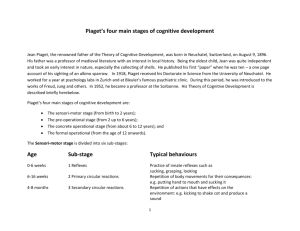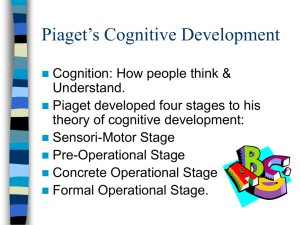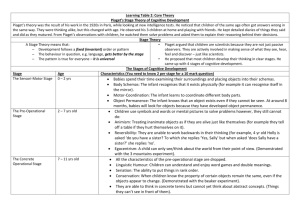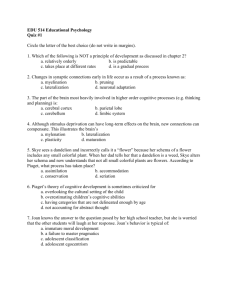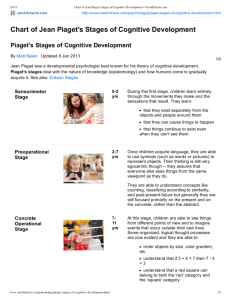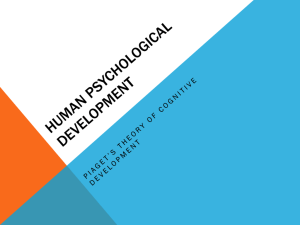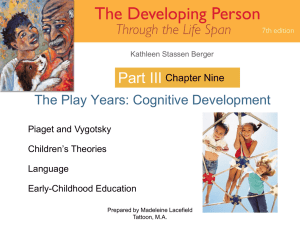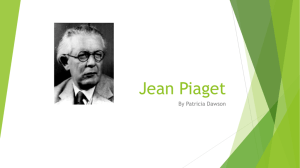Cognitive Development
advertisement
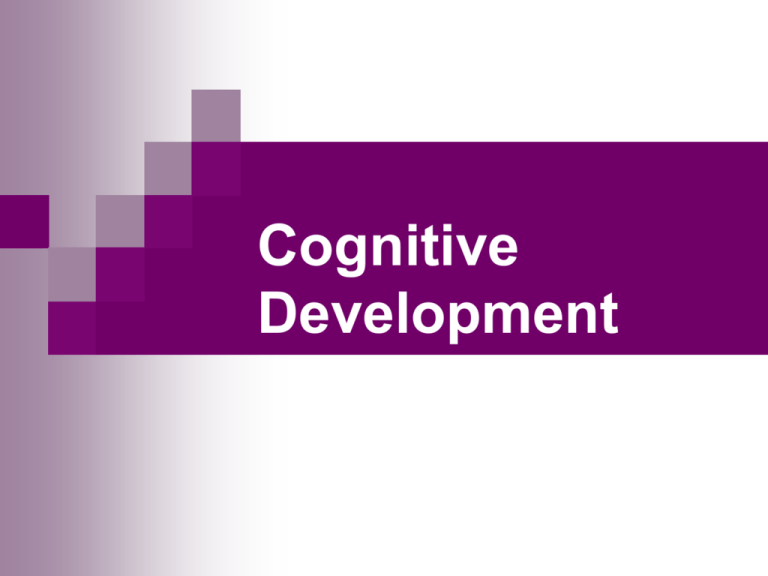
Cognitive Development Jean Piaget Cognitive development theory Children "construct" their understanding of the world through their active involvement and interactions. Studied his 3 children to focus not on what they knew but how they knew it. Described children's understanding as their "schemas” and how they use: assimilation accommodation. Piaget’s Cognitive Development Cognition: How people think & Understand. Piaget developed four stages to his theory of cognitive development: Sensori-Motor Stage Pre-Operational Stage Concrete Operational Stage Formal Operational Stage. Sensori-Motor Stage (0-2 years) Sensory contact understanding. The child explores the world surrounding them using it’s senses Initially sucking/grasping reflex and moving onto reaching for objects out of reach. Object permanence……… Major development within this stage. Initially the baby cannot understand that objects exists out of sight. As the baby reaches around 7/8 months he/she will begin to understand the object/person still exists when out of sight. Pre-Operational stage(2-7yrs old) Toddler can understand the use of symbols and language. This is an example of symbolic thinking. E.g. pretend play. Language is now understood. Development of…….. Animism…child believes inanimate objects have feelings as they do. E.g. ‘bad table. I’ll not talk to you!’ Egocentricism…Can only see the world from their own point of view All these developments take place in the PreOperational Stage. Preoperational Stage (2 to 7 years) •"Operation" - Forms of mental action through which older children solve problems and reason logically •Key feature of stage is extensive representation •Pre-op kids develop “theory of mind” (understanding of mental processes) Some Dimensions of Conservation: Number, Matter, and Length Type of conservation Initial presentation Number Matter Length Two identical rows of objects shown to child Two identical balls of clay shown to child Two sticks are aligned in front of child One row is spaced Experimenter changes shape of one ball Experimenter moves one stick to right “No, the longer one has more” “No, the one on top is longer” Manipulation Preoperational child’s answer to “No, the longer row has more” “Are they still the same?” Concrete Operational Stage (7-11 years) The children are now able to conserve, They understand that although the appearance has changed the thing it self does not. Formal Operational Stage (11- 16 years ) Most of previous characteristics discussed have now developed. The child shows logical thinking and is able to work through abstract problems and use logic without the presence of concrete manipulation. E.g. If Kelly is taller than John and John is taller than Pete who is the tallest? This is an example of inferential reasoning. Inductive reasoning Example: Pendulum problem •Formal operational children will systematically test all possibilities before arriving at a conclusion How fast? Summary of Piaget: Criticisms Underestimated the importance of knowledge Gagne: Complex skills can be acquired easily once simpler prerequisite skills have been learned. Development is based on LEARNING new skills - continuous not discontinuous. Underestimated the ability of children . Tasks were methodologically flawed Underestimated the impact of CULTURE: Piaget’s tasks are culturally biased Schooling and literacy affect rates of development This suggest that there were design flaws with Piagets original study. Summary of Piaget: Criticisms Demand characteristics:- the children may have wanted to please the experimenter therefore changing their behaviour. Social setting:-Piaget ignored the effect of the social setting upon the child.The way adults use language and gestures. Strengths •Active rather than passive view of the child. •Revealed important invariants in cognitive development. •Errors informative. •Perceptual-motor learning rather than language important for development. •Tasks.
